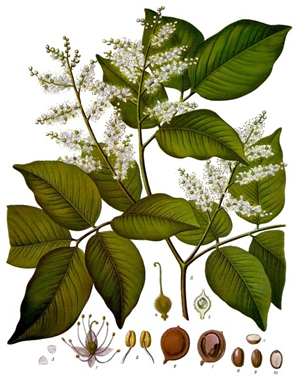Copaiba Balsam Copaifera Officinalis

Franz Eugen KÖhler, 1887
- Common Names
- Copaiba Balsam , balsam, copaiva, Jesuit's balsam, copal, palo de aceite, capivi
- Botanical Name
- Copaifera Officinalis
- Syn. Copaifera langsdorfii, Copaifera jacquinii.
- Family
- FABACEAE
Medicinal Uses & Benefits of Copaiba Balsam
![]() How to Use|
Side Effects |
Plant & Garden|
How to Use|
Side Effects |
Plant & Garden|
- Medicinal Uses: * Athletes Foot/Ringworm
* Bronchitis
* Cuts & Wounds
* Eczema
* Hair
* Psoriasis
- Properties: * Anti-inflammatory * Antibacterial * Antifungal * Demulcent * Skin tonic * Stimulant
- Parts Used: oleoresin obtained from the trunk
- Constituents: resin : caryophyllene, sesquiterpenes, diterpenes, and terpenic acids
How to Use: Copaiba Balsam
Copaiba oil has been documented with antibacterial, diuretic, disinfectant and stimulant properties. The resin contains caryophyllene, a phytochemical with strong anti-inflammatory, fungal and pain relieving properties. The hydrocarbons in copaiba are terpenes, including, pinene, commonly known as turpentine. Copaiba is used topically to relieve inflammation and help heal athlete's foot, eczema and psoriasis, and heals damaged skin with minimal scarring. Shampoos containing copaiba are effective in fighting dandruff.
Copaiba balsam been found most beneficial in chronic coughs, catarrh, colds, bronchitis, and other respiratory problems. Copaiba is often paired with tulu, or Peru balsam in shampoos and skin products, and resembles them in action. 1
Preparation Methods & Dosage :Copaiba oil is used externally, and tinctures are used internally.
Copaiba Balsam Side Effects: Taking very large amounts can be toxic
Plant Description
- Flowers:Small, white flowers in racemes
- Plant Class:Tropical tree - reaches heights of up to 100 feet
- Leaves: Pinnate leathery leaves
- Fruit: Legume containing a single seed
- Preferred Habitat:Rainforest
- Flowering Season:
- Distribution:South America, Brazil, Colombia, and Venezuela
How to Grow Copaiba Balsam
Illegal harvesting and logging has put many species that are the source of aromatic oils in danger. Unless you are certain that the product you are buying comes from a sustainable source, you could be contributing to the extinction of these valuable rainforest species. 2
- Balch, Phyllis A. . "Prescription for Herbal Healing", Avery (2002)
- American Botanical Council
For the past several years, a group of women in Brazil have struggled to promote and perform sustainable harvesting of endangered rosewood trees. The women of AVIVE manufacture aromatic soaps, candles, and products from the oils of many tree species, in addition to rosewoods For instance, they employ oils from andiroba seeds (Carapa guianensis Aubl., Meliaceae) and cumaru seeds (aka tonka beans, Dipteryx odorata [Aubl.] Willd., Fabaceae), as well as copaiba resin/oil (Copaifera spp. L., Fabaceae), breu oil (Protium spp., Burseraceae), and puxuri oil (Licaria pucheri [Ruiz & Pavon] Kosterm., Lauraceae). All of these oils are aromatic, and several of them contain healing properties or work as insect repellents. Like the rosewood, many of the trees that produce the oils are threatened.










